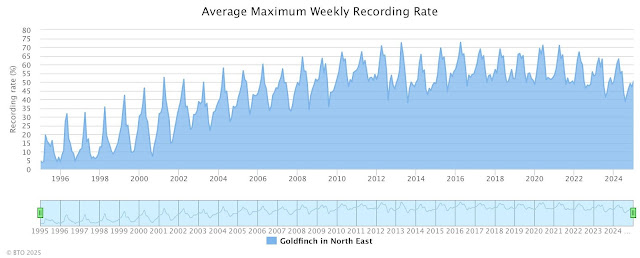The end of 2024 saw the completion of 30 years of data collection and analysis by the British Trust for Ornithology (BTO) Garden BirdWatch (GBW). It has up to 13,000 people submitting up to half million records each year and once a data set gets that big it starts to produce really interesting and valuable results. I have been fortunate to be a member and to have been submitting data from my garden from the start in January 1995. On the GBW website I can look back at my own data but perhaps it is more interesting to examine long-term trends in the North East or the whole country. Two examples, chosen because of observations in my garden, are Rook and Ring-necked Parakeet which show contrasting fortunes. When I moved here in 1989 there was a rookery in the small copse in my garden. The rooks were great fun to have as neighbours but their numbers gradually dwindled from a peak of 44 nests to six nests in 2010. A few birds turned up for a look round but didn't nest in 2011 and there have been none since. The GBW data for gardens in the North East show a steady decline but some people are still fortunate to see them.
I can see from my GBW data that the first time I saw a ring-necked parakeet here was in week 12 (March) 2022. I saw one or two birds until week 17 and then they disappeared. The next record was in week 46 (November) 2022 and they have been here in numbers ever since, up to 15 at a time. Here is the graph for gardens in the North East so this is a bird that is obviously here to stay.
Here they are seen through the kitchen window with the iPhone. Note the three non-native mammals as well. They are even more regular visitors than the parakeets.
Two finches, both very common here, also show contrasting fortunes. Greenfinches have long been in decline nationally, probably mainly because of infection with trichomonosis. In recent weeks here I have been seeing up to nine at a time but this is the national picture, first for presence, then abundance.
.In contrast, goldfinches, which commonly feed alongside greenfinches, are doing well. They seem not to be affected by trichomonosis.
The BTO GBW data shows lots of other winners and losers over the past 30 years. Birds in decline include spotted flycatchers, starlings and collared doves. Those increasing in numbers include wood pigeons, great spotted woodpeckers and magpies. One final comparison I have chosen is between our two sparrows. First house sparrow (a very rare bird in my garden, only two sightings in 30 years),
































